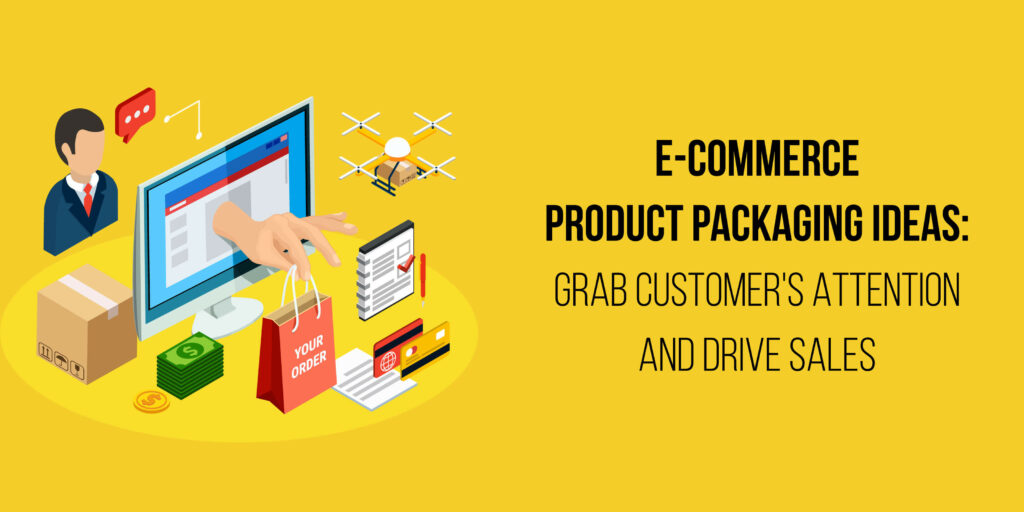
E-commerce Product Packaging Ideas: Grab Customer's Attention and Drive Sales
In the fast-paced world of e-commerce, standing out from the crowd is essential to win the hearts of your customers and drive sales. While a great product and seamless online experience are crucial, one aspect often overlooked is the power of e-commerce product packaging. In this blog post, we’ll explore innovative ideas to create branded product packaging that not only grabs your customers’ attention but also leaves a lasting impression. Get ready to discover the secrets of custom brand packaging and unlock the potential to elevate your e-commerce business!
Why is product packaging important for e-commerce brands?
Product packaging is vital for e-commerce brands because it creates a positive first impression, reinforces brand identity, enhances customer experience, differentiates from competitors, ensures product safety, acts as a marketing tool, and showcases environmental responsibility. By prioritising packaging, e-commerce brands can effectively engage customers, drive sales, and build long-term brand loyalty.
Here is why e-commerce brand product packaging matters:
1. First Impression:
In the world of e-commerce, where customers don’t have the opportunity to physically touch or experience products before purchasing, packaging becomes the first tangible interaction they have with your brand. It creates the first impression and sets the tone for their entire buying experience.
2. Brand Identity:
Packaging serves as a powerful tool for communicating and reinforcing your brand identity. It allows you to showcase your brand’s logo, colours, typography, and overall design aesthetics. Consistent branding across packaging builds brand recognition, instils trust, and helps differentiate your products from competitors.
3. Customer Experience:
E-commerce packaging is not just about delivering the product; it’s about creating a memorable customer experience. When done right, packaging can evoke positive emotions and make customers feel valued and appreciated. Elements like personalised notes, branded freebies, or unique unboxing experiences contribute to customer satisfaction, loyalty, and positive word-of-mouth referrals.
4. Differentiation and Competitive Advantage:
In the saturated e-commerce landscape, standing out from the competition is essential. Well-designed packaging helps your products grab attention and stand out on crowded digital marketplaces. Unique packaging elements, creative designs, and innovative materials can differentiate your brand, attracting potential customers and driving sales.
5. Protection and Safety:
Effective packaging ensures that products are well-protected during shipping and arrive in excellent condition. Sturdy packaging materials and appropriate cushioning minimise the risk of damage, reducing product returns and customer dissatisfaction. By delivering products in pristine condition, you enhance customer trust and confidence in your brand.
6. Marketing and Brand Exposure:
Packaging is not only seen by the recipient but also potentially by others during transit, at the recipient’s location, or even on social media. Eye-catching and well-branded packaging can act as a form of free advertising, as customers might share their unboxing experiences on social platforms. This amplifies brand exposure and can attract new customers who are intrigued by the packaging.
7. Sustainability and Environmental Responsibility:
Consumers today are increasingly conscious of environmental issues and expect brands to demonstrate eco-friendliness. Thoughtful and sustainable packaging choices, such as using recyclable materials or reducing excessive packaging waste, showcase your brand’s commitment to environmental responsibility. This resonates with environmentally-conscious consumers and strengthens the brand’s reputation.
Ways to create attention-grabbing and sales-driven e-commerce product packaging
1. Unleash Your Creativity with Custom Brand Packaging:
When it comes to e-commerce, packaging is no longer just a means to deliver a product. It has become a valuable tool for brand storytelling and creating a memorable unboxing experience. Think outside the box (pun intended) and design custom brand packaging that reflects your brand’s personality. Incorporate eye-catching visuals, unique shapes, or even interactive elements that surprise and delight your customers.
2. Emphasise Branding from the Outside In:
From the moment your package arrives at your customer’s doorstep, it should scream your brand’s identity. Consider using your brand’s colour palette, logo, and typography on the exterior packaging. Don’t be afraid to experiment with bold designs or witty taglines that intrigue and entice recipients to open the box.
3. Unforgettable Unboxing Experience:
The unboxing experience is a golden opportunity to create a memorable moment for your customers. Add a personalised touch by including handwritten thank-you notes, branded stickers, or freebies related to the purchased product. The goal is to evoke positive emotions and make your customers feel special, encouraging them to share their unboxing experiences on social media, and generating valuable word-of-mouth marketing.
4. Sustainable Packaging Solutions:
In today’s environmentally conscious world, sustainable packaging is no longer a luxury; it’s an expectation. Explore eco-friendly packaging options such as recyclable materials, biodegradable packing peanuts, or even plant-based inks for printing. By showcasing your commitment to sustainability, you’ll appeal to eco-conscious customers and position your brand as socially responsible.
5. Functional and Protective Design:
While aesthetics are important, remember that the primary purpose of packaging is to protect the product during transit. Invest in packaging materials that are sturdy and secure, ensuring your products arrive in pristine condition. Consider incorporating innovative features like protective inserts, bubble wraps, or air pillows to safeguard delicate items.
6. Surprise and Delight with Unique Packaging Elements:
Go the extra mile by adding unexpected elements to your packaging that surprise and delight your customers. This could include incorporating a QR code that leads to exclusive content or discount codes, providing assembly instructions with a touch of humour, or even including a small personalised gift that complements the purchased product. Such thoughtful gestures leave a lasting impression and foster customer loyalty.
Conclusion:
In the fiercely competitive world of e-commerce, exceptional product packaging can make all the difference. By embracing custom brand packaging, you can captivate your customers from the moment they receive your package and create a memorable unboxing experience. Incorporating creative design elements, emphasising branding, and prioritising sustainability will not only grab attention but also drive sales and foster customer loyalty. So, step up your e-commerce packaging game, and watch your business flourish in the hearts and minds of your customers.
How Gemius can help e-commerce brands to build their visual design identity?
Gemius specialises in helping e-commerce brands build their visual brand identity, which plays a crucial role in establishing a strong online presence and attracting customers. By leveraging their expertise in visual branding and design, Gemius can assist e-commerce brands in creating a distinct and cohesive visual identity that aligns with their unique offerings and resonates with their target audience.
Here’s how Gemius can assist e-commerce brands with their visual design identity:
Visual Brand Identity Strategy:
Gemius begins by understanding the e-commerce brand’s values, target market, and competitive landscape. They conduct research to gain insights into the brand’s personality, positioning, and desired perception. Based on this information, they develop a comprehensive visual brand identity strategy that outlines key design elements, colour palettes, typography, and imagery styles.
Logo Design:
Gemius creates impactful logos that serve as the centrepiece of a brand’s visual identity. They work closely with the e-commerce brand to understand its essence and design a logo that effectively communicates its unique value proposition. The logo embodies the brand’s personality, evokes emotion, and builds recognition across various touchpoints.
Design Guidelines:
Gemius establishes design guidelines or a style guide to ensure consistency and coherence in the visual branding efforts. These guidelines outline specifications for logo usage, typography, colour schemes, iconography, imagery styles, and other visual elements. The guidelines serve as a reference for the e-commerce brand’s marketing team and any external designers or agencies involved in creating branded assets.
Website and User Interface (UI) Design:
Gemius crafts visually appealing and user-friendly website designs that reflect the e-commerce brand’s visual identity. They pay attention to factors such as layout, colour scheme, typography, and imagery to create a seamless and engaging user experience. The UI design elements are consistent with the overall visual branding, reinforcing brand recognition and trust.
Social Media and Marketing Collateral:
Gemius helps e-commerce brands extend their visual identity across social media platforms and marketing collateral. They design eye-catching social media graphics, banners, and posts that align with the brand’s aesthetics. Gemius also creates templates for brochures, product packaging, advertisements, and other marketing materials, ensuring a consistent visual presence across various channels.
Brand Photography and Videography:
Gemius assists e-commerce brands in capturing high-quality product images and creating compelling brand videos. They work with professional photographers and videographers to ensure that the visuals align with the brand’s identity and convey its unique selling points effectively.
By collaborating with Gemius, e-commerce brands can benefit from their expertise in visual branding and design to create a strong and memorable visual identity. This, in turn, helps build brand recognition, trust, and customer loyalty, ultimately driving the success of the e-commerce business.
FAQs :
Q1. How to design product packaging?
Ans 1: Designing product packaging involves several steps, including:
- Research and understanding the target audience and market trends.
- Defining the brand identity and product positioning.
- Creating a packaging concept that aligns with the brand and product.
- Choosing appropriate materials, colours, typography, and imagery.
- Incorporating essential information such as product details, logos, and legal requirements.
- Developing prototypes and testing the packaging for functionality and aesthetics.
- Iterating and refining the design based on feedback.
- Preparing final artwork for production.
Q2. What are the different types of product packaging?
Ans 2: There are various types of product packaging, including:
- Primary packaging: The immediate packaging that directly holds the product, such as a bottle, box, or blister pack.
- Secondary packaging: The outer packaging that contains and protects the primary packaging, such as a cardboard box or shrink wrap.
- Tertiary packaging: The packaging used for transportation and bulk handling, typically pallets, crates, or shipping containers.
- Luxury packaging: High-end packaging designed to convey premium quality and enhance the product’s perceived value.
- Sustainable packaging: Environmentally friendly packaging solutions that aim to reduce waste and minimise environmental impact.
Q3. What are the 3 levels of packaging?
Ans 3: The three levels of packaging are:
- Primary packaging: This is the immediate packaging that directly comes into contact with the product. It serves to protect and contain the product, and it often includes labels or instructions for use.
- Secondary packaging: This packaging surrounds the primary packaging and provides additional protection during shipping, handling, and display. It typically includes boxes, cartons, or cases.
- Tertiary packaging: Also known as shipping or transportation packaging, this level of packaging is used for bulk handling, storage, and transportation of products. It includes pallets, crates, or shipping containers.
Q4. What are the elements of packaging?
Ans 4: The elements of packaging include:
Structure: The physical shape, size, and format of the packaging.
Materials: The choice of materials used in the packaging, such as paper, plastic, glass, or metal.
Graphics: The visual elements, including logos, typography, colours, and imagery, used to communicate the brand and product information.
Labelling: The information provided on the packaging, such as product name, ingredients, usage instructions, warnings, and legal requirements.
Functionality: The design features that ensure the packaging is easy to open, use, and store, while also providing protection for the product.
Sustainability: The consideration of eco-friendly materials, recyclability, and overall environmental impact in the packaging design.
Branding: The incorporation of brand elements to create a consistent and recognizable identity across different products and packaging.



